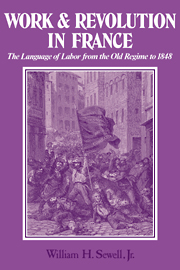Book contents
- Frontmatter
- Contents
- Preface
- 1 INTRODUCTION: SOCIAL HISTORY AND THE LANGUAGE OF LABOR
- 2 MECHANICAL ARTS AND THE CORPORATE IDIOM
- 3 JOURNEYMEN'S BROTHERHOODS
- 4 THE ABOLITION OF PRIVILEGE
- 5 FROM GENS DE MÉTIER TO SANS-CULOTTES
- 6 A REVOLUTION IN PROPERTY
- 7 INDUSTRIAL SOCIETY
- 8 WORKERS' CORPORATIONS
- 9 THE JULY REVOLUTION AND THE EMERGENCE OF CLASS CONSCIOUSNESS
- 10 THE PARADOXES OF LABOR
- 11 THE REVOLUTION OF 1848
- 12 CONCLUSION: THE DIALECTIC OF REVOLUTION
- Notes
- Bibliography
- Index
1 - INTRODUCTION: SOCIAL HISTORY AND THE LANGUAGE OF LABOR
Published online by Cambridge University Press: 06 November 2009
- Frontmatter
- Contents
- Preface
- 1 INTRODUCTION: SOCIAL HISTORY AND THE LANGUAGE OF LABOR
- 2 MECHANICAL ARTS AND THE CORPORATE IDIOM
- 3 JOURNEYMEN'S BROTHERHOODS
- 4 THE ABOLITION OF PRIVILEGE
- 5 FROM GENS DE MÉTIER TO SANS-CULOTTES
- 6 A REVOLUTION IN PROPERTY
- 7 INDUSTRIAL SOCIETY
- 8 WORKERS' CORPORATIONS
- 9 THE JULY REVOLUTION AND THE EMERGENCE OF CLASS CONSCIOUSNESS
- 10 THE PARADOXES OF LABOR
- 11 THE REVOLUTION OF 1848
- 12 CONCLUSION: THE DIALECTIC OF REVOLUTION
- Notes
- Bibliography
- Index
Summary
THE PAST TWENTY-YEARS have seen an enormous proliferation of research on the history of working people. Carried out from widely varying perspectives and trained on many different aspects of working-class life, this research has inevitably generated its share of divergent findings and scholarly controversies. Yet there is almost universal agreement on one point: that skilled artisans, not workers in the new factory industries, dominated labor movements during the first decades of industrialization. Whether in France, England, Germany, or the United States; whether in strikes, political movements, or incidents of collective violence, one finds over and over again the same familiar trades: carpenters, tailors, bakers, cabinetmakers, shoemakers, stonemasons, printers, locksmiths, joiners, and the like. The nineteenth-century labor movement was born in the craft workshop, not in the dark, satanic mill.
This fact has important implications for the practice of labor history. Above all, it suggests that research can no longer be confined exclusively to the period since the industrial revolution. If the labor movement were a specific product of the factory, ignoring the period before factories existed would be defensible. But because it was initiated by artisans, workers in trades with long and rich histories, ignoring the preindustrial period can have only pernicious effects. It is true, of course, that artisans were subjected to new pressures and challenges by the development of industrial capitalism. But their responses were inevitably shaped by values, traditions, and organizational experiences that predated the modern industrial era. The discovery that artisans created the nineteenth-century labor movement makes the problem of continuity with preindustrial forms and experiences impossible to escape.
- Type
- Chapter
- Information
- Work and Revolution in FranceThe Language of Labor from the Old Regime to 1848, pp. 1 - 15Publisher: Cambridge University PressPrint publication year: 1980
- 2
- Cited by

